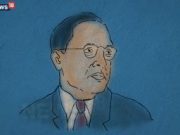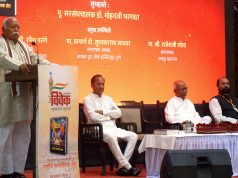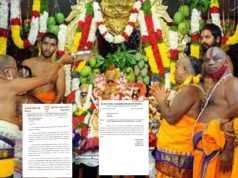
– Ananth Seth
Lord Ram might have faced a 14-year vanvaas in his human form in the Treta-Yug but for Ramlala virajmaan, it has been an arduous journey of more than 4 centuries in the Kalyug. That however seems to be ending now.
On the 24th of March 2020, CM Yogi Adityanath shifted the idol of Ramlala from the tent to a temple complex in Ayodhya. This will be the transitory abode of Ramlala till the grand Ram Mandir comes up at Ayodhya.
But for the pandemic triggered lockdown, the construction of the temple would have started today on the auspicious ocassion of Ram Navami. The October-2019 verdict has paved the way for the construction of the grand temple at Ayodhya and it is a matter of time before Ramlala ensconces himself in a temple befitting his status and legacy.
The following is a compilation detailing Temple Movement and the people who have been involved with or have contributed immensely to the Movement.
THE PEOPLE
Sri Parasaran
The key face in the legal team representing the ‘Hindu Side’ in the Ram Janmabhoomi case, ninety-three year young Parasaran started his legal career from the state of Tamil Nadu and went on to become the Advocate General of that state during 1976. He has also served as the Solicitor General of India and the Attorney General of India.
A Padma Vibhushan awardee, he received a Presidential Nomination to Rajya Sabha, the upper house of the Indian Parliament, in 2012 for a period of six years.
In 2019, he was appointed by government of India to lead the Ram Janmabhoomi Teerth Kshetra Trust. When he was approached by both the rival parties in the Ram Setu case, he chose to go against the government and argued for sustaining the Setu.
An erudite Hindu scholar, he has enjoyed the trust of every ruling dispensation at the centre since 1970s. His courtroom orations are often lectures in Hindu Scriptures.
Even at 93, the ‘Pitama of Indian Bar Association’ is physically and mentally fit (who can forget his insistence on ‘standing and arguing’ despite a polite request from the CJI Gogoi) and raring to go.
Sri Triloki Nath Pandey
TN Pandey is the man who represented Lord Ram for more than a decade. Court documents describe him as the ‘next friend’ of Ramlala who was one of the litigants in the long running dispute. The 75 year young feels proud to be the chosen one amongst more than a Billion Indians.
Mr. Pandey hails from a farming family of UP and is a trained teacher. He was close to RSS in his school days and later in life, he gravitated towards VHP and found his calling. He justifies his and his organizations aggressive attitude by asserting that the diminishing Hindu pride needed assertiveness. He has also been the man who helped the karsevaks, who levelled the disputed structure, get legal aid.
He lives in a single room in the sprawling VHP campus at Ayodhya. After the verdict though, legally he has ceases to be the “next friend” of Ramlala but spiritually, he continues to be with Ramlala.
Sri Kameshwar Chaupal
Chaupal was given the status of ‘first karsevak’ by the RSS. Hailing from Patna, he is known to have laid the first brick of the foundation stone at Ram Temple in 1989. He is a dalit and has even contested LS elections in 1991 against Ram Vilas Paswan
Sri Mahant Dhirendra Das
He is the head of Ayodhya’s Nirmohi Akhara, a body of saints that was one of the main parties from the Hindu side. Nirmohi Akhara claims to have worshipped and cared for Ramlala at Ayodhya for centuries. Even the Supreme Court, in its October 2019 verdict has said that the govt should include representation from Akhara in the Temple Trust.
Sri Ashok Singhal
The International Working President of VHP for over 20 years, Singhal was in-charge of the Ayodhya Ram Janmabhoomi movement. Hailing from Agra, he was a Metallurgical Engineer by qualification and a trained vocalist in Hindustani Music.
He joined RSS in 1944, when he was only 17, under the tutelage of Balasaheb Deoras. In 1980, he was deputed to the VHP and rose to become its General Secretary in 1984. Later, he became the working President of VHP and continued in that position till 2011.
Sri LK Advani
A very senior and prominent leader of the BJP, Advani was the one who gave the much needed political wind and heft to the Ram Janmabhoomi Movement. It was his Rath Yatra which took the Movement to the masses and also helped in establishing BJP as a potent political force and the second pole (and currently, the dominant pole) of the Indian polity.
Sri KK Nair
An ICS Officer hailing from Kerala, he played an unforgettable role in reinstating the fundamental right to worship of Hindus in the Ram Janmabhoomi Movement, much before India became a republic. Born in 1907, he joined as a Civil Servant in Uttar Pradesh in 1945 and became the Deputy Commissioner cum District Magistrate of Faizabad (now Ayodhya) in 1949.
In December of 1949, the then CM of UP, Mr. GV Pant, ordered, at the behest of PM Nehru, that Hindus be expelled from the Temple Complex. Nair refused to implement the order, pointing out that the real stake holders were performing puja and expelling them would lead to riots and bloodshed. Though he was suspended by Pant for this, he fought back legally and won. He later started his legal practise at Allahabad High Court.
Taking the fight for Ram Mandir forward, Nair and his family joined Jan Sangh. His wife Shakuntala became an MLA in the UP Assembly in 1952 and later, in 1962, both he and his wife entered the fourth Lok Sabha from UP. The couple was arrested during the infamous mergency imposed by Indira Gandhi.
THE TIMELINE OF THE MOVEMENT
Though the destruction of the Temple took place in 1528, the issue assumed legal dimension only in 1885 when Mahant Raghubir Das filed a suit in Faizabad (now Ayodhya) Court, seeking permission to build a temple on the land adjoining the Mosque which was constructed upon the destroyed Temple. After failing to get permission from the Court, Mahant Raghubir Das filed a Title Suit in Faizabad Court against the Secretary of State for India, seeking permission to build a temple on the chabootara i.e. the rostrum of the Mosque, only to face rejection again.
Matters rested thus till 1949 when the idol of Lord Ram appeared inside the mosque. For Hindus, this was divine revelation though detractors argued otherwise. Subsequently, two suits were filed in Faizabad court seeking permission to conduct Hindu Poojas for Lord Ram. The court granted permission to conduct pujas though the inner courtyard gates were to remain locked.
Further, in 1959, Nirmohi Akhara and Mahant Raghunath filed another suit seeking possession of the land since they claimed to be the sect responsible for conduct of puja. In 1961, UP Sunni Wakf Board filed a possession suit and also demanded the removal of the idol of Lord Ram.
In 1984, the Ram Janmbhoomi Movement commenced under the aegis of Vishwa Hindu Parishad (VHP), with BJP leader LK Advani leading the campaign. In 1986, a third party – lawyer U C Pandey – appealed, before the Faizabad Sessions Court for the gates to be unlocked, on the grounds that the Faizabad district administration, and not a Court, had ordered its closure. The court ordered the opening of the gates to allow Hindu “pooja and darshan”. Unhappy with this development, Muslims constituted what they called ‘Babri Mosque Action Committee (BMAC).
On 9th of November, 1989, the then Prime Minister Rajiv Gandhi allowed VHP to perform ‘shilanayas’ (laying of foundation stone for the Ram temple) near the mosque. Later, in the same year, all title suits were shifted to Allahabad High Court. Another suit filed by Ram Lalla Virajman in the High Court named Nirmohi Akhara (1959) and Sunni Waqf Board (1961) suits as defendants.
The ’Rath Yatra’ was launched by Advani ji in 1990 from Somnath (Gujarat) to Ayodhya to whip up support for the Ram Janmbhoomi Movement. BJP assumed power in UP in 1991.
On 6th of December, 1992, the disputed structure was removed by Karsevaks (helpers in a religious cause) who also constructed a make-shift temple in its place.
In 1993, Narasimha Rao government issued an ordinance acquiring 67.7 acres of land (the dispute site and adjoining areas). Later, it was passed as a law – Acquisition of Certain Areas at Ayodhya Act, 1993, to facilitate acquisition of land by Central government. The acquisition was upheld by SC which, in its 1994 judgment, reasoned that every religious immovable property is liable to be acquired. The SC adjudged that offering namaz at mosque was not integral to Islam unless that mosque had any particular significance in Islam.
In Feb 2002, the horrific Godhra incident took place wherein Hindu karsevaks were burnt alive in Sabarmati Express, just days after it was announced by VHP that Temple construction would begin by March 2002.
In Apr 2002, Ayodhya Title Dispute case began at High Court and the Archaeological Survey of India (ASI) was ordered by the court to excavate the site to determine if a temple lay underneath the mosque. ASI submitted its report in 2003 which stated that remnants of a 10th century Hindu temple were found in the excavation. Muslims, as expected, questioned the ASI report.
On Sep 30, 2010, the Allahabad HC delivered its judgment, dividing the land between three parties: one third each to Sunni Wakf Board, Nirmohi Akhara and Ram Lalla Virajman. The HC allotted the dome of the demolished Babri Masjid, under which the makeshift temple currently stands, to the Hindus. The nearby Ram Chabutra and Sita Rasoi also went to the Nirmohi Akhara. The one-third share of the Sunni Wakf Board comprises the outer courtyard of the disputed land.
This verdict (of Allahabad HC) was stayed by SC in 2011 which called it strange and admitted a batch of petitions. The issue dragged till Jan 8, 2019, when CJI Gogoi used his administrative powers to list the matter before a 5-judge constitution bench, headed by the CJI himself and comprising Justices S A Bobde, N V Ramana, U U Lalit and D Y Chandrachud. On Jan 10, 2019 Justice U Lalit recused himslef, prompting the Supreme Court to reschedule the hearing to January 29 before a new bench.
In Mar 2019, the Constitution Bench ordered a court-monitored mediation, despite objections from some of the key parties. The mediators were former apex court judge, Justice F.M.I. Kalifulla, as Chairman, spiritual leader Sri Sri Ravishankar and senior advocate Sriram Panchu. The mediation efforts failed and the constitution bench led by the CJI decided to hear the appeals from August 6 on a day-to-day basis.
Finally, on 16th of October, 2019, in a unanimous verdict, Supreme Court cleared the way for the construction of a Ram Temple at the disputed site at Ayodhya by granting the entire 2.77 acre of disputed Ram-Janmbhoomi Babri Masjid land in Ayodhya to deity Ram Lalla.
THE VERDICT
- Possession of disputed land will be handed over to the deity Ram Lalla, one of the three litigants in the case. The land will remain with a central government receiver.
- Centre directed to frame scheme within 3 months and set up a trust for construction of a temple.
- Muslims to be allotted an alternative and suitable land of 5 acre, at a prominent place, to be handed over to Sunni Waqf board building the mosque.
- SC dismisses plea of Nirmohi Akhara seeking control of entire disputed land. However, it asks the Centre to grant representation in the trust to Nirmohi Akhara if deemed fit by the government.
- Babri mosque, demolished on December 6, 1992, was not built on vacant land. Fact that there lay a temple beneath the destroyed structure has been established by the ASI. The underlying structure was not an Islamic structure. ASI had not established whether temple was demolished to build the mosque.
- Hindus consider this place as birthplace of lord Ram, even Muslims say this about disputed place. Faith of Hindus that Lord Rama was born at demolished structure is undisputed. The existence of Sita Rasoi, Ram Chabutra and Bhandar grih are the testimony of the religious fact of the place. Evidence suggests Hindus were in possession of outer court yard.
- Evidence suggest Muslims offered Friday prayers at mosque which indicates they have not lost possession. Despite obstruction caused in offering prayers at Mosque, evidence suggests that there was no abandonment. Muslims have not adduced evidence they were in exclusive possession of dispute site, says SC.
- Title cannot be established on ground of faith, belief; they are kind of indicator for deciding dispute.
- UP Sunni Central Waqf Board has failed to establish its case in Ayodhya dispute. On the contrary, Hindus established their case that they were in possession of outer courtyard.
- Pronouncement of the verdict, which commenced at 10:30am, went on for 45minutes.
- The verdict has attained finality and all the appeals have been disposed
(Author is a Legal Practitioner)












